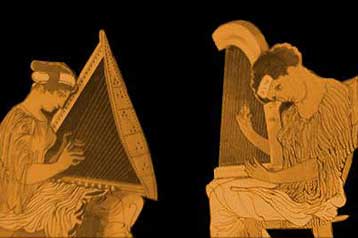Sound of Long-Lost Ancient Greek Instruments Recreated by Computer
18 Μαρτίου 2009
The long-lost sounds of the epigonion, the salpinx and the kithara could be about to form the strangest musical group yet, thanks to the world’s largest physics project.
The epigonion, a harp-like musical instrument, was last played in Ancient Greece. But computer scientists have resurrected its sound as part of a project to conjure up an orchestra of long-lost instruments.
They don’t know exactly what it looked like but they have used historical sources to re-create what it would have sounded like.
“It is a really interesting sound, metallic, crisp and bright,” said Domenico Vicinanza, a Cambridge-based engineer who worked with the Italian project Astra.
“It fits perfectly in Middle Ages and baroque music ensembles, melding wonderfully with strings and woodwinds.”
At a conference in Italy at the weekend, musicians played ancient scores on the epigonion, using an electronic keyboard that simulated its sound.
Now the team is working to bring more old instruments back to life. Next on their list are the salpinx, a trumpet-like instrument of the Ancient Greeks, and the kithara, a type of lyre that was played in the courts of Rome and Athens.
The ultimate aim is a concert played on instruments that have not been heard for more than 2,000 years. The idea and mathematical concepts behind remodelling early instruments have been around since the 1970s, but the amount of information that needed to be processed to put the theories into practice was too great for earlier computers.
Now researchers can tap into the massive computing power of the Grid, a network of computers set up to crunch the enormous amounts of data expected to spill out of the Large Hadron Collider at the CERN nuclear research centre near Geneva.
While the “big bang machine” suffered a catastrophic fault recently, and as a result, is likely to be switched off for at least a year, in the meantime the computing network designed to help to unlock the secrets of the Universe is being put to other uses – such as resurrecting the musical sounds of Ancient Greece.
An epigonion is similar to a modern harp or psaltery, and is mentioned in the works of Athenaeus, the Greek rhetorician and grammarian, in 183AD. Historians believe it was invented, or at least introduced to Greece, by Epigonus, a renowned musician from Ambracia in Epirus, a region that now straddles modern Greece and Albania.
Epigonus was given Greek citizenship as recognition of his great musical ability, having been the first person to pluck the strings of the epigonion with his fingers, instead of using a plectrum. The instrument, which Epigonus named after himself, had 40 strings of varying lengths.
The first instrument the Italian researchers worked on re-creating was a monochord, an instrument played by Pythagoras, the Greek mathematician and scientist. Monochord means “one string”, which was stretched over a soundbox. The successful remodelling of the monochord showed that the researchers could move on to re-create the sounds of other instruments.
This is done through data collected by archaeologists, engineers and historians, who help to describe the materials and shape of the ancient instrument.
This is all translated into a computer program that is run on hundreds of computers in Europe that make up the Grid. The process takes four hours to produce just 30 seconds of music.
But it should now be possible to create whole compositions based on the sounds of the epigonion. The researchers have already used the instrument and their efforts can be heard on the internet.
BLASTS FROM THE PAST
The aulos: Modern reconstructions of the instrument indicate that the aulos produced a low and resonant clarinet sound. Made of two wooden double reed pipes, much like an oboe, it was blown at varying intervals and speeds to produce a tune
The syrinx: Named after the nymph who turned into a reed to hide from Pan, this was the forerunner of the panpipes. A series of wooden tubes, tuned by their differing lengths were blown, creating a soothing sound popular at poetry recitals
The hydraulis: One of the more complicated musical tools used in this era, the ancient organ was powered by a supply of water and air that when combined caused a brass-like effect within the pipes. A well-preserved pottery model was found in Carthage in 1885
The monochord: Consisting of a single string stretched over a sound box with a movable bridge, this instrument was used as a scientific instrument for measuring musical intervals in Ancient Greece
The lyre: This hand-held zither has seven or more strings, each of which is tuned to a different note of one of the modes. It was a popular accompaniment to singing recitals in Ancient Greece and is still used today.




